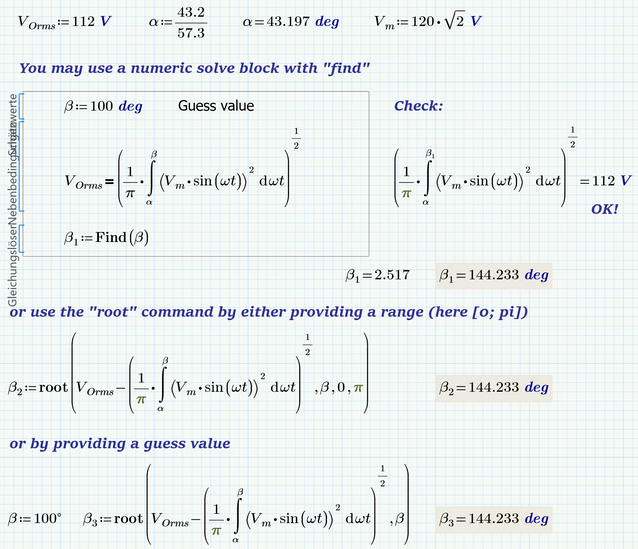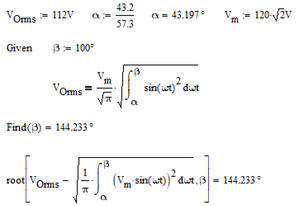Community Tip - Did you get an answer that solved your problem? Please mark it as an Accepted Solution so others with the same problem can find the answer easily. X
- Subscribe to RSS Feed
- Mark Topic as New
- Mark Topic as Read
- Float this Topic for Current User
- Bookmark
- Subscribe
- Mute
- Printer Friendly Page
AC-DC Rectifier Solve Equation
- Mark as New
- Bookmark
- Subscribe
- Mute
- Subscribe to RSS Feed
- Permalink
- Notify Moderator
AC-DC Rectifier Solve Equation
Good Day. I need your help with the following equation
Solved! Go to Solution.
Accepted Solutions
- Mark as New
- Bookmark
- Subscribe
- Mute
- Subscribe to RSS Feed
- Permalink
- Notify Moderator
In Prime (on contrary to real Mathcad like MC15) you can't evaluate a solve block symbolically. Fortunately this is not necessary anyway. As you have specific values you don't need a symbolic solution. You should use Primes numeric methods (solve block or the root command.
Furthermore you type a square bracket. Just use normal parentheses as a square bracket creates a vector/matrix which you sure did not had in mind. Incidentally, that's the reason for the "undefined" message.
Deleting the square bracket gives you a solution, but a wrong, non-real one, because you defined alpha with 43.2 and not with 43.2 deg! alpha:=43.2 means alpha is 43.2 radians!
Remark: When you look at prints made from real Mathcad (MC15&below) you will often see square brackets which actually are typed parenthesis which are simply displayed by Mathcad as square brackets.
Worksheet in format P4 attached
And, yes. Fully agreed on - Prime is quite mediocre compared to real Mathcad (=Mathcad 15 or below).
@luc: You can use units in a solve block with "find" in MC15, too. The problem is when you want to use units in a solve block with "odesolve". Here Prime has a small advantage among all its many disadvantages.
In our case here its especially easy because the unit Volt immediately cancels anyway:
- Mark as New
- Bookmark
- Subscribe
- Mute
- Subscribe to RSS Feed
- Permalink
- Notify Moderator
Hi,
I would like to suggest you work with MATHCAD 15, since PRIME is a beta version, very poor, you just lose time.
Bye
- Mark as New
- Bookmark
- Subscribe
- Mute
- Subscribe to RSS Feed
- Permalink
- Notify Moderator
Is this what you are after?
This was done in Mathcad 11, a predecesor of Mathcad 15 which in turn is a predecessor of Prime. You should know that the newer versions aren't always better than the older. Hence the advice by MFra.
Having a license for Prime means that you are entitled to install Mathcad 15, using the very same license you used for Prime. That should allow you to open the attached file.
But Prime has a few goodies too. In (real) Mathcad you cannot work with units in a solve block. With Prime you can. You could attach V (Volt) to the two voltages, and still solve the problem.
But there are also things you have to watch out for with Prime. Prime 'autolabels' variables. In your case the L in L/10 that you attempt to assign to beta, is a unit, Litre. Also the alpha that you attempt to assign, is a constant. I'm writing 'attempt' here a few times, because you are mixing assignments (to be done with := ), equations (using a bold = ) and evaluations (using a normal = ).
The solve block that I wrote, above, is done in the correct way. First you assign values to the variables/parameters/symbols that you know the value of. It's 'assignment', so you use := (Which you get by typing a simple colon ':' ). then you have to assign a guess value to the variable that you want to solve for (beta in this case) it's assignment again, so use :=. Then you write your constraints. Constraints are written as equations, using bold = (which you get by typing [CTRL-=] ).
Finally you solve your equation with a solver function, such as Find(). You can assign the result found by the Find function to a variable. But you also can directly evaluate the solution found by typing Find(...)=, and here you use the normal = which you get by typing =.
If all this is confusing... consult the Help information of Prime regarding solve blocks.
Success!
Luc
P.S. There is no symbolic solution to the problem, that is, you cannot solve beta as a closed mathematical expression involving the two voltages and alpha.
As confirmed by WolframAlpha with the input string:
"solve (integrate (V*sin^2(phi)) phi=alfa to beta) = W for beta"
- Mark as New
- Bookmark
- Subscribe
- Mute
- Subscribe to RSS Feed
- Permalink
- Notify Moderator
Thank you so much for this help. Full respect, you are the best!
- Mark as New
- Bookmark
- Subscribe
- Mute
- Subscribe to RSS Feed
- Permalink
- Notify Moderator
In Prime (on contrary to real Mathcad like MC15) you can't evaluate a solve block symbolically. Fortunately this is not necessary anyway. As you have specific values you don't need a symbolic solution. You should use Primes numeric methods (solve block or the root command.
Furthermore you type a square bracket. Just use normal parentheses as a square bracket creates a vector/matrix which you sure did not had in mind. Incidentally, that's the reason for the "undefined" message.
Deleting the square bracket gives you a solution, but a wrong, non-real one, because you defined alpha with 43.2 and not with 43.2 deg! alpha:=43.2 means alpha is 43.2 radians!
Remark: When you look at prints made from real Mathcad (MC15&below) you will often see square brackets which actually are typed parenthesis which are simply displayed by Mathcad as square brackets.
Worksheet in format P4 attached
And, yes. Fully agreed on - Prime is quite mediocre compared to real Mathcad (=Mathcad 15 or below).
@luc: You can use units in a solve block with "find" in MC15, too. The problem is when you want to use units in a solve block with "odesolve". Here Prime has a small advantage among all its many disadvantages.
In our case here its especially easy because the unit Volt immediately cancels anyway:
- Mark as New
- Bookmark
- Subscribe
- Mute
- Subscribe to RSS Feed
- Permalink
- Notify Moderator
Werner_E,
Thank you for your advise, your help is invaluable.
- Mark as New
- Bookmark
- Subscribe
- Mute
- Subscribe to RSS Feed
- Permalink
- Notify Moderator
Using Werner_E 09-25-2019 10:31 PM file, I try to find rectifier angles for both turn on and turn off for required effective voltages.
Prime 5 in page 2 has a bug.
If the required effective voltage is smaller than almost 50, The RMS equation shows 0.
The graph line texture is also limited to control to another types.
- Mark as New
- Bookmark
- Subscribe
- Mute
- Subscribe to RSS Feed
- Permalink
- Notify Moderator
Mathcad 15
RMS bug.
- Mark as New
- Bookmark
- Subscribe
- Mute
- Subscribe to RSS Feed
- Permalink
- Notify Moderator
Hi,
do you like the ripple?










